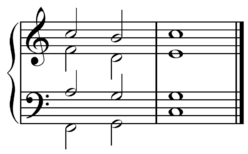Chord progression facts for kids
A chord progression or harmonic progression is a succession of musical chords, which are three or more notes, typically sounded simultaneously. Chord progressions are the foundation of harmony in Western musical tradition from the common practice era of Classical music to the 21st century. Chord progressions are the foundation of Western popular music styles (e.g., pop music, rock music) and traditional music (e.g., blues and jazz).
Contents
Relation to the circle of fifths
The circle of fifths is an idea in music theory that has to do with keys. It also has to do with chord progressions. If you have a song with the chord progression G, C, D, you can see those chords are right next to each other in the circle. So if you want to play the same song in a different key, you can use any other three chords right next to each other. This works for any chord progression.
Common chord progressions
One of the most used chord progressions is based on the first, fourth and fifth notes of a major scale. In the key of C, these are the C, F, and G chords. This progression is used in many simple songs. Since these songs have only three chords, they are sometimes called three-chord songs. Many country, blues, rock, pop and punk songs are three-chord songs.
Related pages
Images for kids
-
The key note, or tonic, of a piece of music is called note number one, the first step of (here), the ascending scale iii–IV–V. Chords built on several scale degrees are numbered likewise. Thus the chord progression E minor–F–G can be described as three–four–five, (or iii–IV–V).
See also
 In Spanish: Progresión armónica para niños
In Spanish: Progresión armónica para niños



